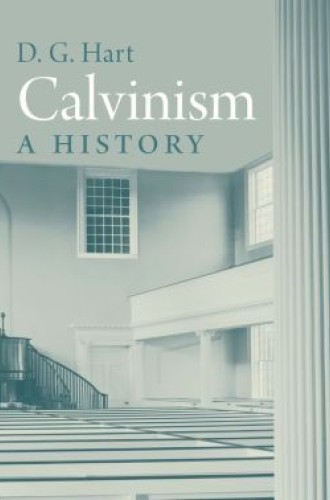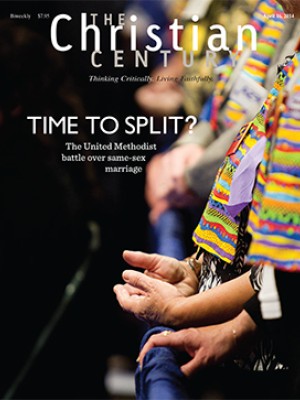Reformed and antimodern
Some classic works on the origins of modernity gave pride of place to Calvinism. Max Weber famously made it the fount of capitalist economics; Robert K. Merton, that of experimental science; Michael Walzer, of political radicalism. In his new history of Reformed churches, D. G. Hart will have none of it. Rather than shaping modern life, he argues, Calvinism developed in reaction to it—sometimes in the negative sense of the word.
Calvinists have not been power brokers with a plan; instead, they have been ordinary folk who, their predestinating deity notwithstanding, found their way to an authentic ecclesiastical tradition by “accidental” and “unlikely ways.” The tradition has managed to spread from “marginal cities in central Europe” to all parts of the globe, but only by considerable trial and one persistent error—the aspiration to be part of the political or social establishment, to take charge of society, to be the culture formers that Merton and Weber espied. To that temptation only a very few have been immune, and they have remained so by adhering to strictly defined forms of doctrine, liturgy, and, above all, polity. That, in sum, is the author’s point of view.
Read our latest issue or browse back issues.
The narrative unfolds in three phases. In phase 1, from Zurich and Geneva in the 1520s through the end of the 17th century, the fortunes of Reformed Protestantism are closely tied to the good graces of civil magistrates. Where these magistrates are hostile—as in Poland, France, and the Palatinate—a budding Calvinist network is crushed or harshly constricted. Where that network enhances political identity, autonomy, or stability, it gains better headway. Thus weak but aspiring polities—Switzerland, Scotland, the Netherlands, and various “nooks and crannies” of the Holy Roman Empire—become the long-term strongholds of the Calvinist cause.
In phase 2 the instruments that the churches use to order their houses prove to be divisive or disappointing, and they generate new departures. These instruments are, first, confessional standards, which generate dissent or complaints of dead orthodoxy, and second, structures of governance that become entangled with either doing or defying the state’s bidding. Accordingly, the frontiers of vitality for Calvinism in the 17th and 18th centuries lie in colonial ventures abroad and in the turn toward pietism and “heart religion” at home.
The results are a mixed bag. The New World of Dutch, English, Scottish, and German settlements is distant enough from the home countries to allow some profitable experimentation, but, especially early on, the settlements still lean heavily on local patrons. Evangelical awakenings, by relocating religion from a public square of formalism and compromise to the interior sphere of personal devotion and relationships, quicken spiritual life but at the cost of institutional salience. Not just civil and university authority but doctrinal canons and ecclesiastical assemblies lose sway under revivalist religion, which is a long shot from the ideals of the Reformed founders.
In phase 3, the 19th and 20th centuries, Calvinists have to devise new modes of identity and initiative under the circumstances of state-church separation. This is a traditional move in church history narrative, but Hart gives it an unusual and revealing turn by focusing on four protest movements: the 1843 Disruption of the Scottish Kirk that produced the Free Church, galvanized by the leadership of Thomas Chalmers; the Dutch Neo-Calvinist project associated with Abraham Kuyper; the fundamentalist uprising in American Presbyterianism led by J. Gresham Machen; and Karl Barth’s work in and beyond the Confessing Church’s defiance of Nazi Germany. On the face of it these four might seem odd bedfellows, but the author’s analysis allows us to see clearly their parallels, distinctions, strengths, limitations, and legacies around the world. Alongside these cases run the mission ventures by which Calvinism, hitched to the wagon of Western imperialism, becomes a worldwide faith.
Hart wraps up the story with a threefold conclusion: that the Reformed tradition has a place in a new, fourth phase of unfolding global Christianity, despite the greater attention usually paid to Pentecostal and Roman Catholic expressions therein; that this place is one more manifestation of Calvinism’s remarkable adaptability across time and space; and that Presbyterian polity—lay-centered and locally sensitive, yet connectional—tops the list of explanations for this outcome.
The great merit of this book is that it pulls so many threads together in a coherent tapestry. The writing is clear and efficient, and readers who object to notes will find that there are just a few tucked away at the back of the book. The bibliography supplies a chapter-by-chapter reading list from which we can infer the particular sources—most of them secondary—on which the author relied.
When covering so many eras, places, and institutions, an author will inevitably err on some details. In the chapter treating the domain I know best, the Dutch Neo-Calvinist tradition, I counted four errors of fact and two strained interpretations. But these did not detract from the overall salience of the argument. In short, this is the book you ought to turn to when you need to know the basics about a particular body in the Reformed household, to read a comparative analysis of ecclesiastical cousins and siblings in a given generation, or to find an interesting diagnosis of the family system that makes this clan tick, in quarreling and comity alike.
That said, readers should be aware of the particular interpretations structuring the book’s argument. Hart’s Calvinism is a very old-fashioned work, so old-fashioned as to be newly revealing. In contrast to the contextual analyses of religion that have dominated the professional guild for at least 40 years, Hart stays very much within the official institutions of Reformed Christianity, calling our attention to dynamics and developments that the looser contextual approach can overlook. The cost of this strategy is to ignore the broader connections and interactions that Calvinists made outside of formal church assemblies—in their workweek activities and in their participation in and impact on politics and education.
It is in these latter domains especially that Reformed laity have been overrepresented over the centuries. On the American side, for instance, the Presbyterian John Witherspoon (whom Hart discusses with respect to church matters) taught more participants in the early U.S. political system than any other single individual, and Calvinists founded well over half of the new nation’s institutions of higher learning before the Civil War. There’s not a word of this in the book. Because it is these broader sociocultural dynamics that the great sages of modernity were exploring in formulating their Calvinist-centric theories, we must conclude that Hart has not answered—or even engaged—their arguments in this volume. But he has certainly given impetus for another volume that does just that. It will doubtless conclude that Calvinism’s interactions with the modern world have been far more checkered than the grand theorists thought, but that there indeed has been interaction and creative contribution.
Hart not only tries to bottle up a movement in institutions, he also radically restricts the institutions that qualify for consideration. Baptists do not figure in his account at all, and the Reformed currents that continue on in, say, American Congregational and New School Presbyterian churches since the 1837 conflict with Old Schoolers go without mention. This derives from Hart’s minimal attention to theology as well as to the whole-life implications of faith. We read about formal statements of doctrine and presumed departures therefrom, but not about the recombination of Calvinist tenets with themes from other traditions or with neglected elements of Calvinism itself. Finally, though the evidence at hand is more than ample, Hart does not explore the splintering effect of the formal creeds he espouses. Strict definition makes for clear ecclesiology but also for a whole lot more ecclesiae to consider. As the Scots Presbyterians especially show, the fight for confessional principle offers fertile ground for the narcissism of small differences.
This book is an antipolitical political history. Political in that it centers on formal institutions of church and state and the relationship between them. Antipolitical in that any concerted venture by believers into the public domain is deemed to entail dreams of reestablishing hegemony in society and to be a threat to the integrity of the church. Activist thus becomes a dirty word in these pages. But there are any number of intermediate locations between quietism and establishmentarianism, and one of Calvinism’s virtues is that it has explored them. That is a subject for another book.







